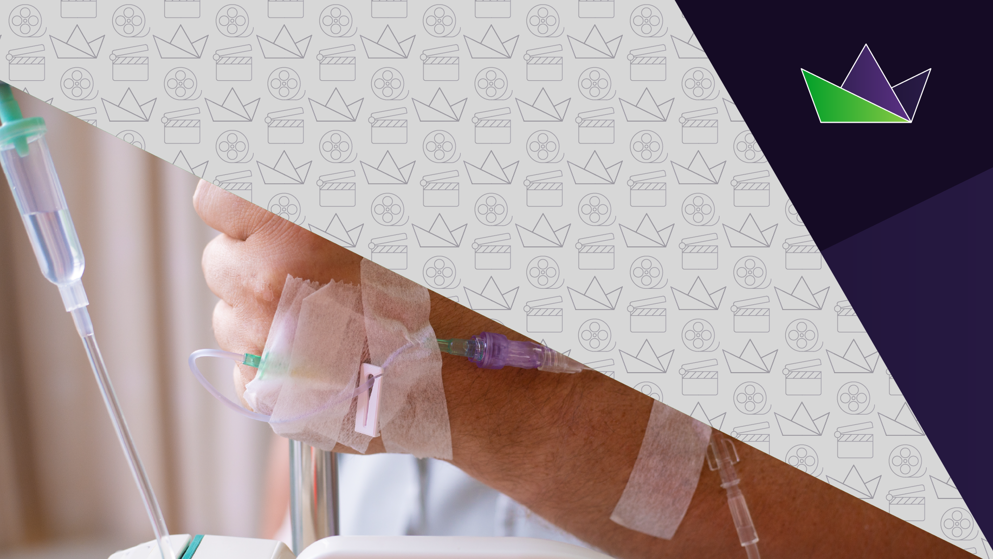
Cancer-associated thrombosis (CAT)
Take an in-depth look at thrombosis in cancer (cancer-associated thrombosis, CAT), the second leading cause of death in patients with malignant tumours.
- Join Professor Agnelli from the University of Perugia to explore the prevalence of CAT and how to identify those at risk
- Explore options for prevention of CAT and for initial, short-term and long-term treatment
- Learn about the key evidence behind inclusion of direct-acting oral anticoagulants (DOACs) as options for prevention and treatment of CAT in 2021 guidelines
About cancer-associated thrombosis
Cancer-associated thrombosis (CAT) collectively refers to thrombotic events in patients with cancer, and most commonly includes types of venous thromboembolism (VTE) such as deep vein thrombosis (DVT) and pulmonary embolism (PE)1. It also includes less common types of VTE, such as visceral or splanchnic vein thrombosis, and arterial occlusion with stroke and symptoms of angina1.
Prevalence and impact of cancer-associated thrombosis
Professor Agnelli describes the prevalence of CAT, and the challenges of treating patients with the condition.
CAT is the second leading cause of death, after deaths from cancer itself, in patients with malignant tumours2
VTE in cancer
Compared with the general population, the risk of VTE is much greater in patients with cancer3. Up to 20% of patients with cancer develop a VTE and it has been estimated that 20% of all VTE cases occur in patients with cancer3.
The annual incidence of VTE in patients with cancer is five times greater than in the general population (0.5% versus 0.1%, respectively)1
The risk of VTE is particularly high in those with active cancer, who are hospitalised and/or undergoing active chemotherapy3. This increased risk has been linked with factors associated with the cancer itself, including a state of hypercoagulability promoted by tumour cells, and the effects of cancer treatments2,4.
For patients with cancer who develop VTE, there is a 3-fold higher risk of recurrent VTE, a 2-fold higher risk of anticoagulation-associated bleeding, and a 10-fold higher risk of death, compared with those without cancer5. VTE may also worsen the patient’s overall quality of life3. Furthermore, VTE may also influence planned chemotherapy regimens3, as chemotherapy is an established risk factor for VTE and certain chemotherapeutic agents have been associated with increased risk of thrombosis (i.e. cisplatin6-9, tamoxifen6).
Arterial thrombosis in cancer
Professor Agnelli discusses the association between arterial thrombotic events and cancer.
According to retrospective and prospective studies, patients with cancer appear to have a higher-than-baseline risk of arterial thromboembolic disease, including coronary heart disease, cardiovascular disease and arterial embolism5. However, none of the cancer-specific VTE guidelines provide advice on management of arterial thromboembolism in patients with cancer, possibly due to lack of high-quality data in this area5.
Risk assessment for cancer-associated thrombosis
Professor Agnelli outlines the key risk factors for cancer-associated thrombosis (CAT), and how clinicians can stratify patients based on their risk of thrombosis, to help inform treatment options.
While cancer is well recognised as a predisposing factor for venous thromboembolism (VTE), it is also a major risk factor for bleeding while on anticoagulant treatment10.
It is important to consider patients’ risk of bleeding whilst on treatment versus their thrombotic risk if taken off treatment, particularly when considering the benefits of extended treatment beyond 3 months or indefinite anticoagulation11. Several risk scores for bleeding and thrombosis have been proposed, with some developed for specific patient situations, including the Khorana risk score for patients with cancer4,11,12.
In this section, we explore the risk factors for VTE in patients with cancer, as well as recommendations for risk assessment and management of VTE in this population10.
Risk factors for VTE in patients with cancer
A combination of general and disease-specific factors, including clinical, biological, treatment-related and cancer-related factors, contribute to the increased risk of VTE in patients with cancer13-15 as outlined in Figure 1.
Figure 1. Factors that contribute to the increased risk of VTE in patients with cancer (Adapted13). VTE, venous thromboembolism.
Among patients with cancer who are receiving systemic cancer therapy, the risks of VTE, bleeding, and early mortality can vary depending on cancer type and treatment, and patient-specific factors including advanced age and male gender3.
Types of cancer that carry the highest risk of VTE include pancreatic cancer, haematological malignancies, lung cancer, gastric cancer and brain cancer10.
The risk of VTE is also particularly high in patients with cancer who3,16-18:
- are hospitalised
- are undergoing active systemic cancer therapy
- have metastatic disease
- are receiving supportive care measures during cancer treatment such as red blood cell transfusions or erythropoietin-stimulating agents to manage anaemia
In those with active cancer, the risk of recurrent VTE is > 8% per year, when anticoagulation treatment is discontinued after the first 3 months10.
Risk of thrombosis: methods to stratify patients with cancer
For patients with cancer who are receiving systemic chemotherapy, it is recommended to stratify patients on the basis of their risk of VTE, using a validated risk assessment tool such as the Khorana risk score19.
The 2022 International Initiative on Thrombosis and Cancer (ITAC), the 2022 National Comprehensive Cancer Network (NCCN) and the 2021 American Society of Haematology (ASH) guidelines recommend using the Khorana score to inform key decisions about thromboprophylaxis in ambulatory outpatients with cancer who are receiving systemic cancer therapy3,12,20.
More details on thromboprophylaxis are provided in Section 3 (Management of cancer-associated thrombosis).
About the Khorana risk score
The Khorana risk score is based on assessment of characteristics associated with increased risk of VTE in patients with cancer (Table 1) and has been externally validated across several studies15.
Table 1. Parameters of the Khorana risk score for chemotherapy-associated VTE in cancer outpatients (Adapted4,12,15). VTE, venous thromboembolism.
| Patient characteristics | Points |
| Site of primary cancer: | |
| Very high risk (stomach, pancreas) | 2 |
| High risk (lung, lymphoma, gynaecological, bladder or testicular) | 1 |
| Prechemotherapy platelet count ≥350 x 109/L | 1 |
| Prechemotherapy haemoglobin level less than 10 g/dL or use of red cell growth factors | 1 |
| Prechemotherapy leukocyte count >11 x 109/L | 1 |
| Body mass index ≥35 kg/m2 | 1 |
Interpretation the Khorana risk score is outlined in Table 2, based on the total score across these parameters.
Table 2. Interpreting the Khorana risk score (Adapted15). VTE, venous thromboembolism.
| Total score | Risk category | Risk of symptomatic VTE |
| 0 | Low | 0.3–1.5% |
| 1 or 2 | Intermediate | 2.0–4.8% |
| ≥3 | High | 6.7–12.9% |
Management of cancer-associated thrombosis
Management of VTE in patients with cancer can be complex, considering cancer not only increases the risk of VTE but is also associated with an increased risk of bleeding3.
Professor Agnelli from the University of Perugia discusses the unmet needs in treating patients with CAT.
Guidelines for managing patients with cancer and VTE
Considering the unique pathophysiology of thrombosis in patients with cancer, as well as additional considerations for treatment, specific guideline recommendations are available to inform management of CAT.
Guidelines for CAT include the:
- 2021 American Society of Hematology (ASH) guidelines3
- 2022 National Comprehensive Cancer Network (NCCN) guidelines15
- 2022 International Initiative on Thrombosis and Cancer guidelines20
Recommendations for management of VTE in patients with cancer are also provided in the:
- 2023 ESMO Clinical Practice Guideline21
- 2019 European Society for Cardiology/European Respiratory Society (ESC/ERS) guidelines10
- 2019 American Society of Clinical Oncology (ASCO) guidelines22
- 2021 ASH guidelines23
- 2021 European Society for Vascular Surgery (ESVS) guidelines11
- 2019 International Society for Thrombosis and Hemostasis (ISTH) guidelines24
The 2022 NCCN and ITAC guidelines and the 2021 ASH, NCCN and ESVS guidelines include the following:
- Routine treatment to prevent blood clots with low-molecular-weight heparins (LHWH) or direct-acting oral anticoagulants (DOACs) should not be offered to all patients with cancer in outpatient settings20
- DOACs are recommended as an option for VTE prophylaxis (thromboprophylaxis) in patients with cancer at intermediate or high risk of thrombosis3,15,20
- Recommendations on types of anticoagulants for use for initial, short and long-term anticoagulation for VTE (deep vein thrombosis [DVT] and pulmonary embolism [PE]) in patients with cancer3,15,20
- Updated recommendations for managing DVT in patients with cancer11
Thromboprophylaxis for patients with cancer at risk of VTE
Anticoagulants recommended for VTE prophylaxis in patients with cancer are outlined in Table 3.
Table 3. Anticoagulants recommended for venous thromboembolism prophylaxis in patients with cancer3,15,20-22,24. ASCO, American Society of Clinical Oncology; DOAC, direct-acting oral anticoagulant; ISTH, International Society on Thrombosis and Haemostasis; LMWH, low-molecular-weight heparin; UFH, unfractionated heparin. *Apixaban thromboprophylaxis recommended for gynaecologic oncology patients only, as data for safety and efficacy are currently restricted to this population only15.
| Patient population | Recommended options for anticoagulation | Guideline |
| Ambulatory patients with cancer | ||
| Patients receiving cancer chemotherapy and at intermediate or high risk of thrombosis (Khorana score ≥2) | DOACs (apixaban, rivaroxaban) or LMHW |
ASH 2021 ASCO 2020 ISTH 2019 NCCN 2022 ESMO 2023 IITC 2022 |
| Hospitalised patients with cancer | ||
| All | LMWH, fondaparinux, UFH If anticoagulation contraindicated: mechanical thromboprophylaxis |
NCCN 2022 IITC 2022 |
| Gynaecologic oncology patients | DOAC (apixaban)*, LMWH, fondaparinux, UFH | NCCN 2022 |
| Post-operatively, following high-risk abdominal or pelvic cancer surgery | DOAC (apixaban) or LMWH (for up to 4 weeks) Extended prophylaxis (4 weeks) with LMWH to prevent postoperative VTE after major abdominal or pelvic surgery (either laparotomy or laparoscopy) is recommended in patients with cancer who do not have a high risk of bleeding (grade 1A) |
NCCN 2022 IITC 2022 |
When choosing an anticoagulant, ensure the patient’s individual risk for thrombosis and major bleeding are taken into account, as well as their preferences, while ensuring the benefits and harms of treatment are discussed with the patient3,15,20. Hospitalised medical oncology patients can continue apixaban/rivaroxaban prophylaxis if either option is already being used in the outpatient setting15. However, apixaban/rivaroxaban should not be initiated in the hospital. Apixaban/rivaroxaban prophylaxis is also an option for patients with a history of heparin-induced thrombocytopenia (HIT) for whom a heparin-based regimen is not feasible15. Note that use of apixaban for VTE prophylaxis is approved in the US for acutely ill medical patients, and both apixaban and rivaroxaban are approved in the US and Europe for those who have undergone hip or knee surgery22–25. Therefore, their use for thromboprophylaxis in patients with cancer is likely to be considered off-label.
Treatment of VTE in patients with cancer
Anticoagulants used for VTE prevention and treatment include unfractionated heparin (UFH), low-molecular-weight heparins (LMWHs), fondaparinux (a synthetic indirect inhibitor of activated factor Xa) and vitamin K antagonists (VKAs)3,15,20. In recent years, DOACs have also been included in guidelines as a recommended option for treatment of VTE in patients with cancer, based on evidence from key clinical trials3,10,15,20,23,24.
Key considerations that guide the choice of anticoagulant for patients with cancer and VTE include risk of bleeding, patient preferences and potential drug interactions25. DOACs (apixaban or rivaroxaban) are preferred for patients at low risk of bleeding25. For those at high risk of bleeding, LMWH are preferred25. Guidelines advise caution with the use of DOACs in patients with gastrointestinal or genitourinary tract cancers because of an increased risk of bleeding in these populations3,10,11,15,20,22. If apixaban, rivaroxaban or LMWHs are contraindicated, unsuitable or inaccessible, alternatives such as dabigatran, UFH, fondaparinux or a VKA may be considered3,15,20,22. Recommendations on anticoagulant for initial, short-term and long-term treatment are summarised in Table 4.
Table 4. Choice of anticoagulant per phase of VTE treatment in patients with cancer3,10,11,15,20,23. DOAC, direct-acting oral anticoagulant; DVT, deep vein thrombosis; LMWH, low-molecular-weight heparin; UFH, unfractionated heparin; VKA, vitamin K antagonist; VTE, venous thromboembolism.
| Treatment phase | DOAC | LMWH |
| Initial (first week) |
✓ Preferred over LMWH, UFH and fondaparinux for patients not on chemotherapy or at low risk of interactions with chemotherapeutic agents, and those without: · active gastrointestinal or genitourinary cancer · thrombocytopenia · liver or renal failure |
✓ Preferred over UFH and fondaparinux Preferred over DOAC for patients with active cancer and DVT |
| Short term (3–6 months) |
✓ Suggested in preference to LMWH and VKAs |
✓ |
| Long term (>6 months, for secondary prophylaxis) |
✓ Ongoing treatment is recommended |
Switch to DOAC after 3–6 months in patients with active cancer and DVT |
Figure 2. Treatment of CAT (Adapted21). CAT, cancer-associated thrombosis; DVT, deep vein thrombosis; GI, gastrointestinal; HIT, heparin-induced thrombocytopenia; LMWH, low-molecular-weight heparin; UFH, unfractionated heparin; VKA, vitamin K antagonist. a) UFH to consider in patients with creatinine. b) Fondaparinux if previous HIT. c) Caution in patients receiving potent inhibitors of P-glycoprotein and CYP3A4 or with luminal GI cancers. d) There are some clinical situations in which these are contraindicated: triple positive antiphospholipid syndrome, renal failure with creatinine clearance.
Risk of bleeding: Some DOACs more than others
A higher rate of major bleeding (including gastrointestinal [GI] bleeding) was previously reported with the use of DOACs, compared with LMWHs, in patients with gastrointestinal cancer26-28; however, recent clinical trial and meta-analyses data suggest this is not the case for all DOACs26,27,29-32.
- In a recent meta-analysis of 31 randomised clinical trials (RCTs)33:
- Apixaban had the lowest bleeding risk in terms of major bleeding and gastrointestinal bleeding
- Rivaroxaban had the lowest bleeding risk in terms of intracranial haemorrhage
- Edoxaban had the lowest bleeding risk in terms of fatal bleeding
- Apixaban had the lowest bleeding risk when used to prevent VTE
According to another recent meta-analysis of 37 RCTs, rates of major GI bleeding differ among groups administered with different doses and types of DOACs34.
- 10 mg apixaban was associated with a lower risk of major GI bleeding than 300 mg dabigatran, 15 mg rivaroxaban and 60 mg edoxaban34
- There were no between-group differences in bleeding risk associated with 300 mg dabigatran, 15 mg rivaroxaban or 60 mg edoxaban34
The risk of major GI bleeding was lower in those given 30 mg daily edoxaban compared with those given 10 mg daily rivaroxaban34. No major GI bleeding risk differences were found in patients given 5 mg daily apixaban, 30 mg daily edoxaban, or 220 mg daily dabigatran34
Edoxaban and rivaroxaban were associated with an increased risk of major bleeding associated with the GI tract, particularly in patients with GI cancer, compared with dalteparin (a LMWH)26,27,32.
- Apixaban was not associated with an increased risk of major bleeding, including major GI bleeding, compared with dalteparin30,35. There was no statistically significant increase in major bleeding for apixaban compared with placebo31
- Preliminary data from a single-centre study in patients with GI malignancies considered the risk of bleeding with DOACs as similar to LMWH29. After 6 months, the difference in major bleeding rates for DOACs and LMWH was not statistically significant29. Details of which DOACs were used by patients in this study were not reported
In patients with non-valvular atrial fibrillation, there was an overall higher risk of major bleeding with DOACs associated with age ≥75 years36. However, bleeding complications were similar versus warfarin in elderly cancer patients with VTE37.
Key considerations when choosing an anticoagulant
When choosing an anticoagulant for treatment of VTE or thromboprophylaxis, it is important to consider the risk of recurrent VTE events balanced with the risk of anticoagulant-related bleeding, as well as the impact on mortality and quality of life, financial costs, and patient values and preferences3,15,20.
Duration of treatment
When managing VTE in patients with cancer, treatment is recommended for at least 3–6 months, or for as long as the cancer is active, the patient remains on cancer therapy or remains at high risk of recurrent VTE3,15,20. The ASH 2021 guidelines also suggest consideration of continuing treatment indefinitely if the benefits of long-term anticoagulation outweigh the risks of treatment3.
Anticoagulants for VTE
A summary of oral and parenteral anticoagulants for prevention and/or treatment of VTE is provided in Table 5. Figure 3 presents the treatment algorithm of CAT in special populations.
Table 5. Overview of anticoagulants for prevention and/or treatment of VTE3,10,11. APTT, activated partial thromboplastin time; CrCl, creatinine clearance; DOAC, direct-acting oral anticoagulant; INR, international normalised ratio; LMWH, low-molecular-weight heparin; UFH, unfractionated heparin; VKA, vitamin K antagonist; VTE, venous thromboembolism.
| Anticoagulant type | Notes |
| Orally administered | |
| DOACs · Factor Xa inhibitors: apixaban, rivaroxaban, betrixaban and edoxaban · Direct thrombin inhibitor: dabigatran |
Lead-in parenteral anticoagulation required for edoxaban, dabigatran Higher initial dose required for apixaban and rivaroxaban (first 7 days or 3 weeks, respectively) |
| VKAs · Warfarin, acenocoumarol, phenprocoumon |
Requires INR monitoring for dose adjustment Lead-in parenteral anticoagulation (heparins or fondaparinux), duration based on INR measurement |
| Parenterally administered | |
| LMWH · Enoxaparin, dalteparin |
Subcutaneous administration (weight-based dosing) Lower risk of inducing major bleeding and heparin-induced thrombocytopenia compared with UFH |
| Fondaparinux | Subcutaneous administration (weight-based dosing) Lower risk of inducing major bleeding and heparin-induced thrombocytopenia compared with UFH |
| UFH | Intravenous administration (dose informed by body weight and APTT) Usually for use in special clinical situations such as severe renal insufficiency (CrCl <30 mL/min, severe renal impairment), haemodialysis, pending interventions, or for critically ill patients |
Figure 3. Treatment algorithms of CAT in special populations (Adapted21). BMI, body mass index; CAT, cancer-associated thrombosis; CrCl, creatinine clearance; LMWH, low-molecular-weight heparin; UFH, unfractionated heparin; VKA, vitamin K antagonist.
For further details on requirements for dose adjustment, contraindications, drug–drug interactions and use of these anticoagulants in specific populations (including hepatic and renal impairment, and the elderly), refer to the relevant Prescribing Information.
For recommendations on which anticoagulant to choose for specific patient populations, refer to relevant VTE and/or CAT management guidelines.
Direct-acting oral anticoagulants in cancer-associated thrombosis
Professor Agnelli discusses the evidence for direct-acting oral anticoagulants (DOACs) in the treatment of venous thromboembolism (VTE) in patients with cancer, and whether DOACS may help to overcome some challenges in managing CAT.
Note : DOACs were previously referred to as new oral anticoagulants or non-vitamin K antagonist oral anticoagulants (NOACs)10.
There are currently five DOACs available, four of which are factor Xa inhibitors (apixaban, rivaroxaban, betrixaban and edoxaban) and one is a direct thrombin inhibitor (dabigatran)3. These DOACs have approved indications for prevention of VTE in restricted populations, or treatment of VTE across the US and Europe, except for betrixaban, which has been approved by the FDA but not the EMA38-47. While none of the approved DOAC indications are specific to patients with cancer, these patients may be encompassed under broader approved indications in adults for prevention or treatment of DVT or PE, and/or prevention of recurrent DVT or PE in adults38-45.
Key evidence for DOACs in prevention and treatment of VTE in patients with cancer
The key evidence that supports inclusion of DOACs as recommended options for prevention or treatment of VTE in patients with cancer is summarised in Tables 6 and 7, respectively3. The ASH 2021 guidelines considered this evidence to support inclusion of DOACs as an option for3:
- thromboprophylaxis in ambulatory patients with cancer receiving systemic chemotherapy
- initial, short-term and long-term treatment of VTE
Table 6. Key evidence for use of DOACs in VTE prophylaxis in patients with cancer3,48-51. AE, adverse event; CI, confidence interval; CRNM, clinically relevant non-major bleeding; DVT, deep vein thrombosis; HR, hazard ratio; LMWH, low-molecular-weight heparin; PE, pulmonary embolism; RR, relative risk; VTE, venous thromboembolism; UFH, unfractionated heparin. *Determination of statistical significance (P value) was not reported in the source publication. †Composite of objectively confirmed proximal DVT in a lower limb, PE, symptomatic DVT in an upper limb or distal DVT in a lower limb, and death from VTE and was assessed up to day 18050. ‡Prespecified supportive analysis involving the same population as primary efficacy analysis (all patients who had undergone randomisation) with assessment during the intervention period (first receipt of trial agent to last dose plus 2 days)50.
| Study | Study population and treatment regimen | Outcomes |
| Phase 2 (Pilot) Double-blind up to 84 days (12 weeks) N = 125 Levine et al, 2012 |
Adult patients with advanced or metastatic cancer receiving chemotherapy Apixaban (5 mg, 10 mg or 20 mg; once daily) or placebo |
Major bleeding: 0–6.3% in apixaban groups vs 3.4% in placebo* CRNM: 3.1–6.3% in apixaban groups vs 0% in placebo* VTE (DVT ± PE): 0% in apixaban groups vs 10.3% in placebo* Grade ≥3 AEs: 3.4–12.5% in apixaban groups vs 13.8% in placebo* |
| AVERT Phase 2 Double-blind up to 180 days N = 574 Carrier et al, 2019 |
Ambulatory patients with cancer and Khorana score ≥2 (intermediate to high risk for VTE) initiating chemotherapy Apixaban (2.5 mg; twice daily) versus placebo |
VTE: 4.2% in apixaban group vs 10.2% in placebo group (HR 0.41, 95% CI, 0.26–0.65; P<0.001) Major bleeding episode: 3.5% in apixaban groups vs 1.8% in placebo group (HR 2.00, 95% CI, 1.01–3.95; P=0.045) |
| CASSINI Phase 3b Double-blind up to 180 days N = 841 Khorana et al, 2019 |
Ambulatory patients with cancer and Khorana score ≥2 (intermediate to high risk for VTE) initiating chemotherapy Rivaroxaban (10mg; once daily) versus placebo |
Up to day 180 Composite of DVT, PE and death from VTE†: 6.0% in rivaroxaban group vs 8.8% in placebo group (HR 0.66, 95% CI, 0.40–1.09; P=0.10) Major bleeding: 2.0% in rivaroxaban group vs 1.0% in placebo group (HR 1.96, 95% CI, 0.59–6.49; P=0.26) Intervention period‡ Composite of DVT, PE and death from VTE†: 2.6% in rivaroxaban group vs 6.4% in placebo group (HR 0.40, 95% CI, 0.20–0.80*) |
| VALERIA Phase 3 Open-label up to 30 days N = 228 Longo de Oliveira et al 2022 |
Patients undergoing major gynaecological cancer surgery, have received thromboprophylaxis with LMWH, fondaparinux, or UFH during the index hospitalisation Rivaroxaban (10 mg; once daily) or enoxaparin (40 mg; once daily) |
Composite of symptomatic VTE and VTE-related death or asymptomatic VTE at 30 days: 3.51% in rivaroxaban group vs 4.39% in enoxaparin group (RR 0.80, 95% CI 0.22 to 2.90; P=0.7344) Primary bleeding event: 0% in rivaroxaban group vs 2.63% in enoxaparin group (HR, 0.14, 95% CI, 0.007- 2.73; P=0.1963 |
Table 7. Key evidence for use of DOACs in the treatment of VTE in patients with cancer3,26,27,35,52-54. AE, adverse event; CI, confidence interval; CRNM, clinically relevant non-major bleeding; HR, hazard ratio; IU, international units; SPVT, splanchnic vein thrombosis; VTE, venous thromboembolism. *Including symptomatic pulmonary embolism (PE), incidental PE, or symptomatic lower extremity proximal deep vein thrombosis (DVT)27. †Determination of statistical significance (P value) was not reported in the source publication. ‡No hazard ratio was reported in source reference.
| Study | Study population and treatment regimen |
Outcomes |
| Initial and short-term treatment (up to 6 months) | ||
| SELECT-D Phase 3 Open label, up to 6 months of treatment N = 406 Young et al, 2018 |
Patients with active cancer and VTE* Rivaroxaban (15 mg twice daily for 3 weeks, then 20 mg once daily for a total of 6 months) versus dalteparin (200 IU/kg daily during month 1, then 150 IU/kg daily for months 2–6) |
Recurrent VTE over 6 months: 11% with dalteparin vs 4% with rivaroxaban (HR 0.43, 95% CI, 0.19–0.99)† Major bleeding: 4% for dalteparin and 6% for rivaroxaban (HR 1.83, 95% CI, 0.68–4.96)† CRNMB: 4% for dalteparin and 13% for rivaroxaban (HR 3.76, 95% CI, 1.63–8.69)† |
| ADAM-VTE Phase 3 Open-label, up to 6 months of treatment N = 300 McBane et al, 2020 |
Patients with cancer-associated VTE Apixaban (10 mg twice daily for 7 days, then 5 mg twice daily for 6 months) versus dalteparin (200 IU/kg for one month followed by 150 IU/kg once daily) |
Major bleeding: 0% for apixaban vs 1.4% for dalteparin (P=0.138)‡ VTE recurrence: 0.7% for apixaban vs 6.3% for dalteparin (HR 0.099, 95% CI, 0.013–0.780; P=0.0281) Composite of major bleeding and CRNMB: 6% (both groups)† |
| CARAVAGGIO Phase 3 (non-inferiority study) Open-label, up to 6 months of treatment N = 576 Agnelli et al, 2020 |
Patients with cancer with symptomatic or incidental acute proximal DVT or PE Apixaban (10 mg twice daily for the first 7 days, followed by 5 mg twice daily) or dalteparin (200 IU/kg once daily for 1 month, then 150 IU/kg once daily) |
Recurrent VTE: 5.6% in apixaban group vs 7.9% in dalteparin group (HR 0.63, 95% CI, 0.37–1.07; P<0.001 for non-inferiority) Major bleeding: 3.8% in apixaban group vs 4.0% in dalteparin group (HR 0.82, 95% CI, 0.40–1.69; P=0.60) |
| CASTA DIVA 2022 Phase 3 (noninferiority study) Open-label, up to 3 months of treatment N = 158 Planquette et al. 2022 |
Patients with active cancer who had proximal DVT, PE or both Rivaroxaban (15 mg twice daily for 3 weeks followed by 20mg once daily for 9 weeks) or dalteparin (200 IU/kg once daily for 1 month followed by 150 IU/kg once daily for 2 months) |
Cumulative incidence of recurrent VTE (symptomatic or incidental DVT or PE, and worsening of pulmonary vascular or venous obstruction): 6.4% in rivaroxabarin group vs 10.1% in dalteparin group; SHR, 0.75; 95% CI, 0.21-2.66). Major bleeding: 1.4% in rivaroxabarin group vs 3.7% in dalteparin group; SHR, 0.36; 95% CI, 0.04-3.43 |
| Hokusai VTE Phase 3 (non-inferiority study) Open-label, 6–12 months of treatment N = 1050 Raskob et al, 2018 |
Patients with cancer and acute symptomatic or incidental VTE LMWH for ≥5 days followed by · edoxaban (60 mg once daily) or · dalteparin (once daily; 200 IU/kg for 1 month, then 150 IU/kg) |
Composite of recurrent VTE or major bleeding at up to 12 months: 12.8% for edoxaban vs 13.5% for dalteparin (HR 0.97, 95% CI, 0.70–1.36; P=0.006 for non-inferiority) Recurrent VTE: 7.9% for edoxaban vs 11.3% for dalteparin (HR 0.71, 95% CI, 0.48–1.06; P=0.09) Major bleeding: 6.9% for edoxaban vs 4.0% for dalteparin (HR 1.77, 95% CI, 1.03–3.04; P=0.04) |
| Long-term treatment (>6 months) |
||
| Post hoc analysis of Hokusai VTE N = 567 Di Nisio et al, 2019 |
A post hoc analysis of follow-up period from 6–12 months | Composite of recurrent VTE or major bleeding: 2.4% for edoxaban vs 2.2% for dalteparin (HR 1.05, 95% CI, 0.36–3.05†) Recurrent VTE: 0.7% for edoxaban vs 1.1% for dalteparin†‡ Major bleeding: 1.7% for edoxaban vs 1.1% for dalteparin (HR 1.47, 95% CI, 0.36–5.99)† |
References
- Elyamany G, Alzahrani AM, Bukhary E. Cancer-associated thrombosis: An overview. Clinical Medicine Insights: Oncology. 2014;8:129-137.
- Fernandes CJ, Morinaga LTK, Alves JL, Castro MA, Calderaro D, Jardim CVP, et al. Cancer-associated thrombosis: The when, how and why. European Respiratory Review. 2019;28(151).
- Lyman GH, Carrier M, Ay C, Di Nisio M, Hicks LK, Khorana AA. American Society of Hematology 2021 guidelines for management of venous thromboembolism: prevention and treatment in patients with cancer. Blood Adv. 2021;5(4):927–974.
- Khorana AA, Kuderer NM, Culakova E, Lyman GH, Francis CW. Development and validation of a predictive model for chemotherapy-associated thrombosis. Blood. 2008;111(10):4902-4907.
- Streiff MB, Abutalib SA, Farge D, Murphy M, Connors JM, Piazza G. Update on guidelines for the management of cancer-associated thrombosis. Oncologist. 2021;26(1):e24-e40.
- Oppelt P, Betbadal A, Nayak L. Approach to chemotherapy-associated thrombosis. Vascular Medicine (United Kingdom). 2015;20(2):153-161.
- Seng S, Liu Z, Chiu SK, Proverbs-Singh T, Sonpavde G, Choueiri TK, et al. Risk of venous thromboembolism in patients with cancer treated with cisplatin: A systematic review and meta-analysis. Journal of Clinical Oncology. 2012;30(35):4416-4426.
- Zahir MN, Shaikh Q, Shabbir-Moosajee M, Jabbar AA. Incidence of venous thromboembolism in cancer patients treated with cisplatin based chemotherapy - a cohort study. BMC Cancer. 2017;17(1).
- Moore RA, Adel N, Riedel E, Bhutani M, Feldman DR, Tabbara NE, et al. High incidence of thromboembolic events in patients treated with cisplatin-based chemotherapy: A large retrospective analysis. Journal of Clinical Oncology. 2011;29(25):3466-3473.
- Konstantinides SV, Meyer G, Becattini C, Bueno H, Geersing GJ, Harjola VP, et al. 2019 ESC Guidelines for the diagnosis and management of acute pulmonary embolism developed in collaboration with the European Respiratory Society (ERS) The Task Force for the diagnosis and management of acute pulmonary embolism of the European Society of Cardiology (ESC). Euro Heart J. 2020;41(4):543–603.
- Kakkos SK, Gohel M, Baekgaard N, Bauersachs R, Bellmunt-Montoya S, Black SA, et al. European Society for Vascular Surgery (ESVS) 2021 clinical practice guidelines on the management of venous thrombosis. European Journal of Vascular and Endovascular Surgery. 2021;61(1):9-82.
- Mulder FI, Candeloro M, Kamphuisen PW, Di Nisio M, Bossuyt PM, Guman N, et al. The Khorana score for prediction of venous thromboembolism in cancer patients: A systematic review and meta-analysis. Haematologica. 2019;104(6):1277-1287.
- Falanga A, Schieppati F, Russo L. Pathophysiology 1. mechanisms of thrombosis in cancer patients. Cancer Treatment and Research. 179: Springer International Publishing; 2019. p. 11-36.
- this reference needs to be recategorised
- National Comprehesive Cancer Network. NCCN Clinical Practice Guidelines in Oncology: cancer-assoicated venous thromboembolic disease. https://www.nccn.org/professionals/physician_gls/pdf/vte.pdf. Accessed March 2023.
- Lyman GH, Eckert L, Wang Y, Wang H, Cohen A. Venous thromboembolism risk in patients with cancer receiving chemotherapy: A real‐world analysis. The Oncologist. 2013;18(12):1321-1329.
- Lyman GH, Culakova E, Poniewierski MS, Kuderer NM. Morbidity, mortality and costs associated with venous thromboembolism in hospitalized patients with cancer. Thrombosis Research. 2018;164:S112-S118.
- Bohlius J, Wilson J, Seidenfeld J, Piper M, Schwarzer G, Sandercock J, et al. Recombinant human erythropoietins and cancer patients: Updated meta-analysis of 57 studies including 9353 patients. Journal of the National Cancer Institute. 2006;98:708-714.
- Lyman GH, Carrier M, Ay C, Di Nisio M, Hicks LK, Khorana AA, et al. American Society of Hematology 2021 guidelines for management of venous thromboembolism: prevention and treatment in patients with cancer. Blood Adv. 2021;5(4):927-974.
- Farge D, Frere C, Connors JM, Khorana AA, Kakkar A, Ay C, et al. 2022 international clinical practice guidelines for the treatment and prophylaxis of venous thromboembolism in patients with cancer, including patients with COVID-19. Lancet Oncol. 2022;23(7):e334–347.
- Falanga A, Ay C, Di Nisio M, Gerotziafas G, Jara-Palomares L, Langer F, et al. Venous thromboembolism in cancer patients: ESMO Clinical Practice Guideline. Annals of Oncology. 2023.
- Key NS, Chb MB, Khorana AA, Kuderer NM, Bohlke K, Lee AYY, et al. Venous thromboembolism prophylaxis and treatment in patients with cancer: ASCO clinical practice guideline update. Journal of Clinical Oncology. 2019;38:496-520.
- Ortel TL, Neumann I, Ageno W, Beyth R, Clark NP, Cuker A, et al. American Society of Hematology 2020 guidelines for management of venous thromboembolism: treatment of deep vein thrombosis and pulmonary embolism. Blood Adv. 2020;4(19):4693–4738.
- Wang TF, Zwicker JI, Ay C, Pabinger I, Falanga A, Antic D, et al. The use of direct oral anticoagulants for primary thromboprophylaxis in ambulatory cancer patients: Guidance from the SSC of the ISTH. Journal of Thrombosis and Haemostasis. 2019;17(10):1772-1778.
- Gervaso L, Dave H, Khorana AA. Venous and arterial thromboembolism in patients with cancer: JACC: CardioOncology state-of-the-art review. JACC: CardioOncology. 2021;3(2):173-190.
- Young AM, Marshall A, Thirlwall J, Chapman O, Lokare A, Hill C, et al. Comparison of an oral factor Xa inhibitor with low molecular weight heparin in patients with cancer with venous thromboembolism: Results of a randomized trial (SELECT-D). J Clin Oncol. 2018;36:2017-2023.
- Raskob GE, van Es N, Verhamme P, Carrier M, Di Nisio M, Garcia D, et al. Edoxaban for the treatment of cancer-associated venous thromboembolism. New England Journal of Medicine. 2018;378(7):615-624.
- Kraaijpoel N, Di Nisio M, Mulder FI, Van Es N, Beyer-Westendorf J, Carrier M, et al. Clinical impact of bleeding in cancer-associated venous thromboembolism: Results from the Hokusai VTE cancer study. Thrombosis and Haemostasis. 2018;118(8):1439-1449.
- Angelini DE, Attia D, Wei WMS, Wilks ML, Tripp B, D'Andrea C, et al. Bleeding outcomes of gastrointestinal cancer patients treated with direct oral anticoagulants vs. low molecular weight heparin. 2020.
- Ageno W, Vedovati MC, Cohen A, Huisman M, Bauersachs R, Gussoni G, et al. Bleeding with apixaban and dalteparin in patients with cancer-associated venous thromboembolism: Results from the Caravaggio study. Thrombosis and Haemostasis. 2021;121(5):616-624.
- Ladha D, Mallick R, Wang TF, Caiano L, Wells PS, Carrier M. Efficacy and safety of apixaban for primary prevention in gastrointestinal cancers: A post-hoc analysis of the AVERT trial. Thrombosis Research. 2021;202:151-154.
- Mulder FI, van Es N, Kraaijpoel N, Di Nisio M, Carrier M, Duggal A, et al. Edoxaban for treatment of venous thromboembolism in patient groups with different types of cancer: Results from the Hokusai VTE Cancer study. Thrombosis Research. 2020;185:13-19.
- Chen J, Lv M, Wu S, Jiang S, Xu W, Qian J, et al. Severe bleeding risks of direct oral anticoagulants in the prevention and treatment of venous thromboembolism: A network meta-analysis of randomised controlled trials. Journal of Vascular Surgery. 2022;75(4):1494.
- Chen X, Wang L, Li H, Huang W, Zhao L, Guo W. Comparative differences in the risk of major gastrointestinal bleeding among different direct oral anticoagulants: An updated traditional and Bayesian network meta-analysis. Front Pharmacol. 2022;13:1049283.
- Agnelli G, Becattini C, Meyer G, Muñoz A, Huisman MV, Connors JM, et al. Apixaban for the treatment of venous thromboembolism associated with cancer. New England Journal of Medicine. 2020;382(17):1599-1607.
- Souverein PC, van den Ham HA, Huerta C, Merino EM, Montero D, León-Muñoz LM, et al. Comparing risk of major bleeding between users of different oral anticoagulants in patients with nonvalvular atrial fibrillation. British Journal of Clinical Pharmacology. 2021;87(3):988-1000.
- Iwai C, Jo T, Konishi T, Kumazawa R, Matsui H, Fushimi K, et al. Comparative safety and effectiveness of direct oral anticoagulants and warfarin during chemotherapy in cancer patients with venous thromboembolism aged 75 years or older: A nationwide inpatient database study. Gerontology. 2022.
- Eliquis® (apixaban) full prescribing information. Last revised April 2021: Administration USFaD; 2021.
- Xarelto® (rivaroxaban) full prescribing information. Last updated January 2021: Administration USFD; 2021.
- Apixaban EPAR product information. Last revised July 2021: Accord Healthcare SLU; 2021.
- Rivaroxaban EPAR product information. Last updated December 2021: Accord Healthcare SLU; 2021.
- Pradaxa® (dabigatran) full prescribing information. Last updated April 2021: Food US, Drug A; 2021.
- Edoxaban tosilate EPAR product information. Last updated January 2022: Daiichi Sankyo Europe Gm BH; 2020.
- Dabigatran etexilate mesilate EPAR product information. Last updated January 2022: Boehringer Ingelheim International Gmb H; 2020.
- Savaysa® (edoxaban) full prescribing information. Last updated April 2021: Administration USFD; 2021.
- Bevyxxa® (betrixaban) full prescribing information. Last revised June 2017: Administration USFD; 2017.
- European Medicines Agency. Dexxience® (betrixaban). 2018. Available at: https://www.ema.europa.eu/en/medicines/human/EPAR/dexxience.
- Levine MN, Gu C, Liebman HA, Escalante CP, Solymoss S, Deitchman D, et al. A randomized phase II trial of apixaban for the prevention of thromboembolism in patients with metastatic cancer. Journal of Thrombosis and Haemostasis. 2012;10(5):807-814.
- Carrier M, Abou-Nassar K, Mallick R, Tagalakis V, Shivakumar S, Schattner A, et al. Apixaban to prevent venous thromboembolism in patients with cancer. New England Journal of Medicine. 2019;380(8):711-719.
- Khorana AA, Soff GA, Kakkar AK, Vadhan-Raj S, Riess H, Wun T, et al. Rivaroxaban for thromboprophylaxis in high-risk ambulatory patients with cancer. New England Journal of Medicine. 2019;380(8):720-728.
- Longo de Oliveira ALM, de Oliveira Pereira RF, Agati LB, Ribeiro CM, Kawamura Suguiura GY, Cioni CH, et al. Rivaroxaban versus enoxaparin for thromboprophylaxis after major gynecological cancer surgery: the VALERIA trial. Clin Appl Thromb Hemost. 2022;28:10760296221132556.
- Di Nisio M, van Es N, Carrier M, Wang TF, Garcia D, Segers A, et al. Extended treatment with edoxaban in cancer patients with venous thromboembolism: A post-hoc analysis of the Hokusai-VTE Cancer study. Journal of Thrombosis and Haemostasis. 2019;17(11):1866-1874.
- McBane RD, Wysokinski WE, Le-Rademacher JG, Zemla T, Ashrani A, Tafur A, et al. Apixaban and dalteparin in active malignancy-associated venous thromboembolism: The ADAM VTE trial. Journal of Thrombosis and Haemostasis. 2020;18(2):411-421.
- Planquette B, Bertoletti L, Charles-Nelson A, Laporte S, Grange C, Mahé I, et al. Rivaroxaban vs dalteparin in cancer-associated thromboembolism: A randomized trial. Chest. 2022;161(3):781-790.
of interest
are looking at
saved
next event
This content has been developed independently by Medthority who previously received educational funding in order to help provide its healthcare professional members with access to the highest quality medical and scientific information, education and associated relevant content.






